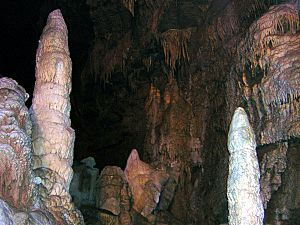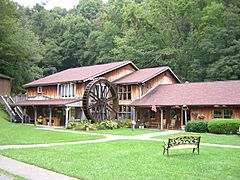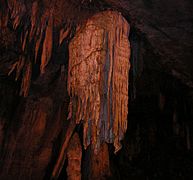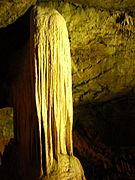Lost World Caverns facts for kids
Quick facts for kids Lost World Caverns |
|
|---|---|

Stalagmite and stalactite formations.
|
|
| Lua error in Module:Location_map at line 420: attempt to index field 'wikibase' (a nil value). | |
| Location | Lewisburg, West Virginia |
| Designated | 1973 |
Lost World Caverns is an amazing underground cave system. It is located near Lewisburg, West Virginia. This natural wonder is filled with incredible rock formations. In November 1973, it became a National Natural Landmark. This means it is a very special place in nature. The caverns are known for their unique stalagmites, flowstone, and even underground waterfalls.
Contents
Exploring the Caverns: A Journey Underground
Lost World Caverns offers a fantastic adventure for visitors. You can explore a huge main chamber on a walking tour. This chamber is about 1,000 feet long, 300 feet wide, and 120 feet high! It's like walking through a giant underground room.
Amazing Rock Formations
Inside the caverns, you'll see many cool rock formations. These include the "Bridal Veil," "Goliath," and "Snowy Chandelier." There's also the "Ice Cream Wall" and the "Castle." These names help you imagine what the formations look like.
One of the most famous formations is the "War Club." It's a tall stalagmite that stands 28 feet high. In 1971, a man named Bob Addis set a record here. He sat on top of the "War Club" for almost 16 days! This amazing feat even made it into the Guinness World Records.
Wild Tours for Adventurers
If you're feeling extra adventurous, you can take a "wild" tour. These guided tours go into the rougher, more remote parts of the cave. You might see places like the "Angel's Roost" or the "Hall of the Mountain King." These tours let you experience the cave in a more natural way.
The History of Lost World Caverns
The caverns were first called "Grapevine Cave." The only way in was a long, deep hole. Farmers used to throw trash and dead animals into it.
Discovery and Development
In 1942, a group from Virginia Polytechnic Institute and State University explored the cave. They "discovered" its hidden passages. In the 1960s, they mapped out the cave. They found it had over a mile of connected tunnels. These passages go down 245 feet below the ground!
In 1967, scientists found the bones of a prehistoric cave bear inside. This bear, called Arctodus pristinus, lived a very long time ago.
In the early 1970s, a new entrance was dug. All the old trash was removed. Walkways were built to make it safe for visitors. Soon after, the cave opened for tourism. Over the years, the lighting has been improved. This helps protect the cave from algae growth. A dinosaur museum was also added to the gift shop!
Fun and Unusual Stories
Lost World Caverns has been part of some interesting stories. In 1992, a newspaper called Weekly World News wrote about the cave. They claimed that "Bat Boy" lived there. They even said the FBI captured him in the caverns! Of course, this was just a fun, fictional story.
In November 2021, a music group named Sloppy Jane did something unique. They recorded their entire album, Madison, inside the cavern! Imagine making music in such a cool, echoey place.
Protecting the Cave Environment
Lost World Caverns is part of a special natural area. This area is called a karst landscape. It means the ground is made of limestone that water can easily dissolve. This creates caves, sinkholes, and underground rivers.
Water and Wildlife
The cave system is connected to the Greenbrier River. Water flows through the cave and eventually reaches the river. This shows how surface water and underground water are linked. Local schools and groups like the Greenbrier River Watershed Association teach people about this connection. They help everyone understand how important it is to protect the cave and its water.
The cave is surrounded by farms. This means air, water, and other things flow into the cave. There are many sinkholes in this area, about 18 per square kilometer!
Keeping Bats Safe
Bats live in the caverns. It's very important to protect them from a disease called white nose syndrome. This disease harms bats in the Appalachian region. Visitors on the "wild" tours are asked to clean their gear and clothes carefully. This helps stop the spread of germs and keeps the bats healthy.
Planning Your Visit
Lost World Caverns is open every day. It closes only on major holidays like Thanksgiving, Christmas Day, and New Year's Day.
As of December 2021, tickets for adults cost $12. For children aged 6–12, tickets are $6. Kids under 6 years old can enter for free.
When you visit, make sure to wear good shoes with grip. The cave stays cool, around 52 degrees F. So, dress in layers to stay comfortable!
Photo gallery
-
The "Snowy Chandelier" stalactite formation
-
Stalagmite formation
See also









